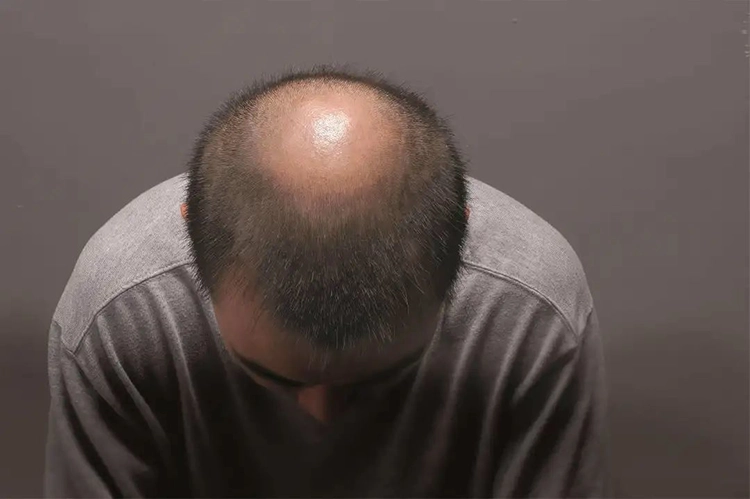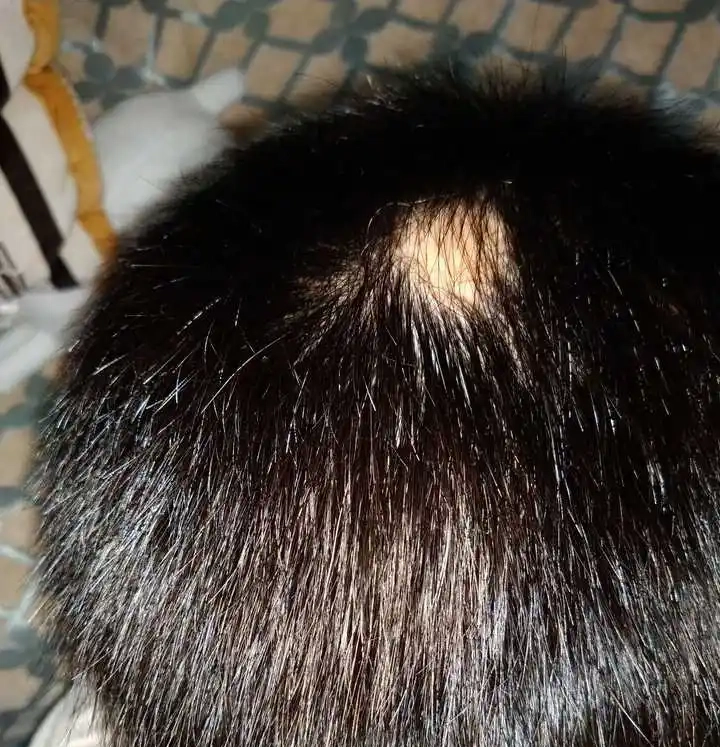Have you ever had:
When you wash your hair, you lose a bunch of it;
When I comb my hair, I can’t bear to look at the comb covered with hair.
When I run my hands through my hair, though I am careful, my hair still falls down.
You fall asleep with your hair on your pillow…
Often encounter this tragic hair loss scene, many people’s first thought is that the lack of Qi and blood, age, anxiety…
Few people would think that the problem of hair loss is actually because of a serious lack of vitamin D in your body.

Vitamin D also plays an important role in hair
Vitamin D is a group of fat-soluble steroid derivatives synthesized intracellularly in the epidermal keratin under the influence of ultraviolet light and diet.
Vitamin D is hydroxylated by 25-hydroxylase and 1-α hydroxylase to produce the biologically active 1, 25-dihydroxyvitamin D3, which directly or indirectly regulates cell proliferation, differentiation, and apoptosis.

Vitamin D receptor is a nuclear receptor that mediates the biological function of vitamin D. It is widely found in most tissues and cells in the body such as bone, kidney, intestine and skin, as well as in hair follicle keratinocytes and dermal papilla cells, and regulates body metabolism.
At present, diseases related to vitamin D and its receptor have been found to be rickets, osteoporosis, diabetes, tumor, systemic lupus erythematosus and so on. Recent studies have found that vitamin D and its receptors also play important roles in hair.
Methods: A total of 152 literatures were retrieved. The titles and abstracts were read and screened, and irrelevant literatures, duplicates and incomplete data were excluded. The articles published recently or in authoritative journals in the same field were selected. The types of literature mainly include experimental studies, clinical studies and review literature.

Vitamin D receptor and hair follicle stem cells
Hair is derived from follicle stem cells in the hair follicle protuberance region.
After the structure of the lower part of the hair follicle is degraded and destroyed, a few hair follicle stem cells in the hair protuberance are activated, which rapidly proliferate and differentiate to form new hair follicles and hairs.
During this differentiation process, hair follicle stem cells are regulated by some signals. The Wnt signaling pathway activates the transcription of related target genes, thereby promoting the renewal, proliferation and differentiation of hair follicle stem cells.
Researchers at the University of Pennsylvania reported in the latest issue of the American Journal of Clinical Investigation that one of the reasons for hair loss is a defect in hair follicle stem cells that leads to hair failure to grow, and an abnormal Wnt signaling pathway in hair follicle stem cells prevents hair regeneration.

In recent years, studies have also found that vitamin D receptor knockout mice (that is, mice that have been gene edited to remove vitamin D receptors) have reduced hair follicle stem cells, which promote hair follicle stem cells to regenerate hair follicles by activating vitamin D receptors; At the same time, vitamin D receptors regulate the activity of the Wnt signaling pathway effectors in hair follicle stem cells.
Vitamin D receptor deficiency can damage the Wnt signaling pathway in hair follicle stem cells, resulting in abnormal proliferation and differentiation of hair follicle stem cells, and then lead to hair loss.
Therefore, vitamin D receptors promote the proliferation and differentiation of hair follicle stem cells, ensuring normal hair growth and hair loss.

Vitamin D and its receptors and the hair growth cycle
The hair growth cycle refers to a continuous series of processes from growth to loss of hair.
The hair growth cycle is divided into growth period, regression period and resting period, and each hair follicle carries out periodic changes independently, even if the adjacent hair follicles are not in the same growth cycle. The disturbance of hair growth cycle can lead to diseases such as alopecia.

The human vitamin D receptor is composed of 6 functional regions, the main two functional regions are:
The ligand binding region mediates binding to 1, 25-dihydroxyvitamin D3; The DNA-binding region recognizes vitamin D response elements and thereby alters local DNA conformation.
When vitamin D binds to its receptor, the receptor’s conformation changes, exposing the DNA-binding region.
Vitamin D receptors form heterodimers with retinoic acid X receptors that bind to vitamin D response elements and regulate transcription and translation of target genes.

Vitamin D receptors and hair follicle keratinocytes
Animal studies have shown that vitamin D receptors are important for the proliferation and differentiation of hair follicle keratinocytes.
Hair follicle keratinocytes that lack vitamin D receptors are blocked in the hair growth cycle.
Increased levels of vitamin D receptors during the end of growth and degenerative stages cause keratinocytes to proliferate more slowly and differentiate more rapidly.
These changes encourage the hair growth cycle to continue over and over again, and a lack of vitamin D receptors slows keratinocyte differentiation and hair follicle growth, leading to hair loss.

Vitamin D resistant rickets
Vitamin D-resistant rickets type IIA is an autosomal recessive disorder caused by deficiency of vitamin D receptors. Clinical manifestations include alopecia generata, hypocalcemia, hypophosphatemia, hyperparathyroidism, rickets, osteomalacia, and caries. The symptoms of alopecia generata are not alleviated by a high-calcium diet.
Children with vitamin D resistant rickets type IIA are born with normal hair, but begin to lose hair at 1 to 3 months after birth. Histologically, the lower two-thirds of the hair follicle is missing and replaced by irregular epithelioid structures and epithelioid cysts. The normal structure of the hair follicle is destroyed, leading to the occurrence of hair loss.
These results suggest that vitamin D receptors directly affect the normal structure of hair follicles. Therefore, vitamin D receptor is expected to be one of the ways to treat vitamin D resistant rickets type IIA hair loss.

Alopecia areata
Alopecia areata is an inflammatory autoimmune disease that occurs in the hair follicles, where histopathology reveals an infiltration of T cells around and within the hair follicles.
Vitamin D receptor is widely expressed in monocytes, dendritic cells, antigen-presenting cells, and activated B lymphocytes and T cells. Deficiency of vitamin D receptor leads to immune system disease.
In recent years, researchers have found that the expression of vitamin D receptor mRNA and protein in hair follicles of patients with alopecia areata is reduced, and the expression of β-catenin, Wnt3a, Wnt5a, and Wnt10b in the Wnt signaling pathway is also reduced.

Wnt signaling pathway inhibitor DKK1 was used to intervene, and vitamin D receptor expression was found to be decreased. It was found that T cells of vitamin D receptor knockout mice had a significant inflammatory response, which was twice that of the body’s lymphocyte response.
Therefore, the researchers speculated that the reduced vitamin D receptor blocked the transduction of the Wnt signaling pathway and induced inflammation in the hair follicles, causing the hair follicles to enter the degenerative phase earlier, resulting in hair loss.
Therefore, by repairing the Wnt signaling pathway and increasing the expression of vitamin D receptor, it is expected to be a new method to treat alopecia areata.

Psoriatic alopecia
Carpotriol, a vitamin D derivative, is widely used to treat psoriasis.
Vitamin D can inhibit the excessive proliferation of keratinocytes and induce keratinocyte differentiation, and significantly increase the ratio of hair growth to rest period.
Some scholars have used capotriol to treat psoriatic alopecia, and the best effect of treatment was achieved in the 8th week, with significant hair growth.
Therefore, vitamin D in the treatment of psoriatic alopecia has broad prospects and needs to be widely used.

Growing Alopecia
Animal models confirm that vitamin D derivative calcitriol has a positive effect on growing alopecia caused by cyclophosphamide.
In mice, local administration of calcitriol 0.45 μg before chemotherapy could not prevent the occurrence of growth alopecia, but it could accelerate the hair regeneration after chemotherapy.
Therefore, the scholars speculated that topical administration of calcitriol stimulated the regeneration of undamaged hair follicles.

The researchers then further placed calcitriol intramuscularly injected mice in the radiation field, and the number of hair follicles did not change significantly, while the number of hair follicles in the control group without calcitriol intramuscularly injected mice decreased significantly.
The study further speculates that upregulating the vitamin D receptor may have a role in preventing hair loss.
Therefore, vitamin D may be effective in preventing and treating growth baldness caused by chemical and radioactive substances, and its effect on growth baldness caused by other causes needs to be further studied.

Vitamin D receptor gene polymorphism and hair loss
The activity and quantity of vitamin D receptor are directly regulated by vitamin D receptor gene, and the change of vitamin D receptor gene directly affects the realization of the biological function of vitamin D receptor.
The human vitamin D receptor gene is located on the long arm of chromosome 12 and contains 11 exons with a total length of 75kb on the genome.
The vitamin D receptor contains 427 amino acid residues. At present, there are 4 polymorphic sites of vitamin D receptor genes related to individual growth and development, corresponding to restriction endonuclidene enzymes BsmⅠ, ApaⅠ, TaqⅠ and FoKⅠ.
Vitamin D receptor gene polymorphism affects the expression and stability of vitamin D receptor mRNA, and can cause the difference in the number or activity of vitamin D receptor protein.

Nicolaidou et al. found that BsmⅠ and TaqⅠ polymorphisms showed significant differences between vitamin D-resistant rickets type IIA group and normal control group, and differences in the number and activity of vitamin D receptor led to the occurrence of alopecia.
At the same time, gene polymorphism is significantly different among different races and nationalities, so further investigation in the population is needed to clarify the relationship between vitamin D receptor polymorphism and hair loss, and provide a possibility for gene treatment of hair loss.

In summary, some conclusions can be drawn:
1. Vitamin D can start the hair growth cycle, has the ability to prevent hair loss and stimulate hair regeneration.
2. Vitamin D receptor plays an important role in hair growth, initiating the hair growth cycle, ensuring the normal development of various signal transduction pathways and promoting the proliferation and differentiation of hair follicle stem cells.
3. Vitamin D receptor deficiency and vitamin D receptor gene polymorphism lead to alopecia and other diseases.
However, the exact mechanism of action of vitamin D and its receptor is not fully understood, and the role of vitamin D and its receptor in hair needs to be further explored.
This provides a possibility for the clinical treatment of hair loss by adjusting the expression of vitamin D receptor, and also provides a theoretical basis for how to supplement and apply vitamin D in patients with hair loss. It is also expected to use vitamin D and vitamin D receptor drug preparations to treat and prevent various hair loss.

